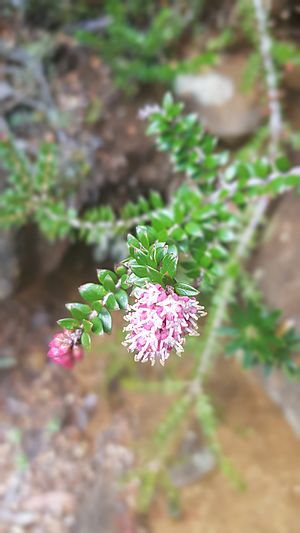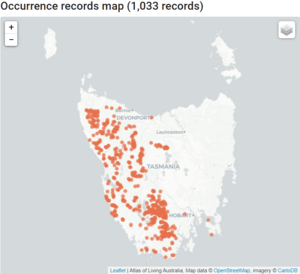Trochocarpa cunninghamii facts for kids
Quick facts for kids Trochocarpa cunninghamii |
|
|---|---|
 |
|
| Trochocarpa cunninghamii in bloom on Tarn Shelf Track, Mt Field National Park, Tasmania February 2020 | |
| Scientific classification | |
| Genus: |
Trochocarpa
|
| Species: |
cunninghamii
|
 |
|
| Occurrence records from Atlas of Living Australia | |
| Synonyms | |
|
|
Trochocarpa cunninghamii is a type of flowering plant. It belongs to the Ericaceae family, which also includes blueberries. People often call it the straggling purpleberry. This is because its fruits are round, flat, and a pretty purple color.
This plant is a woody shrub. It usually grows in the understorey (the layer of plants below the main trees) of rainforests and subalpine forests. You can find it in the Central Plateau and western Tasmania. It is endemic to Tasmania, meaning it grows naturally only there.
Contents
What Does It Look Like?
T. cunninghamii is a low, spreading shrub. It often has new growth that is reddish in color. Its leaves are small, about 5 to 10 millimeters long. They grow in a way that makes them stick out at right angles from the stem. The top side of the leaf is dark green, and the bottom side is lighter. If you look closely at the underside, you can see 5 to 7 veins.
In summer, this plant has pink and white flowers. They are shaped like tubes and hang in spikes near the ends of the branches. The fruit is a purplish blue-black color. It is round and flat, about 1 centimeter wide. You can often see these fruits on the plant all year round.
How to Tell It Apart From Similar Plants
Sometimes, T. cunninghamii can look like other plants in the same group. For example, it looks a bit like Trochocarpa gunnii. However, T. cunninghamii is a low, spreading plant, usually 0.2 to 1.5 meters tall. T. gunnii is much taller, growing 3 to 6 meters high. T. cunninghamii also tends to grow in higher, colder places.
Another similar plant is Trochocarpa disticha. This one is a larger shrub with bigger leaves. It is mostly found in the far southeast of Tasmania and is not very common.
Here are some easy ways to spot T. cunninghamii:
- It has noticeable reddish new growth.
- Its leaves stick out at right angles from the stem.
- You can see 5 to 7 veins on the underside of its leaves.
- It grows as a low, spreading (prostrate) shrub.
- It is an understorey plant, meaning it grows under taller trees.
- It only grows in Tasmania.
Plant Naming and History
The first time this plant was officially described was in 1839. A scientist named Augustin Pyramus de Candolle gave it the name Decaspora cunninghami. Later, in 1963, another scientist, Winifred Curtis, moved it to the Trochocarpa group.
Most plant experts, like the Council of Heads of Australasian Herbaria, agree with the name Trochocarpa cunninghamii. However, some online sources, like Plants of the World Online, think it might be the same as Trochocarpa disticha.
Where Does the Name Come From?
The name of the plant group, Trochocarpa, comes from two Greek words. Trochos means "wheel" and carpos means "fruit." This name was chosen because the fruit of these plants has ten small, single-seeded parts. These parts are arranged in a way that looks a bit like the spokes of a wheel.
The second part of the name, cunninghamii, honors a famous English botanist named Allan Cunningham. He traveled around Australia between 1816 and 1839 to collect different plants.
Where It Lives
T. cunninghamii is found only in Tasmania. It likes to grow in subalpine forests and rainforests. You will most often find it in the understorey layer of forests. This is especially true in the Central Plateau and the western parts of Tasmania.
Sometimes, T. cunninghamii can also be found in alpine woodlands. These are areas with small trees and rocky ground at very high altitudes. Almost all records of this plant are from the western half of Tasmania.

